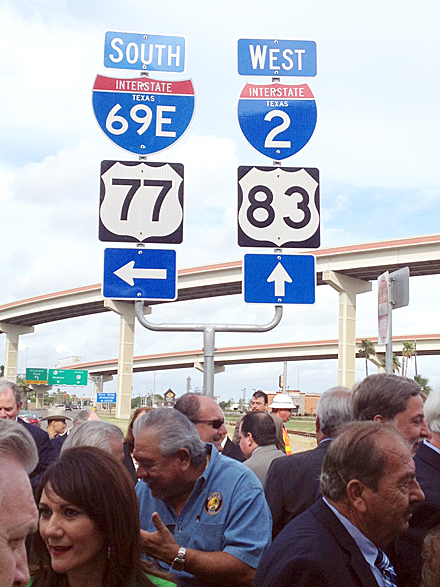- South Texas Students Meet Accordion Music Icons Los Tigres Del Norte In Edinburg Thanks To Khs America/Hohner Alianza Académica Initiative
- Fragile Planet Offers a Nighttime Wildlife Experience
- Falcons Soccer Off & Running
- Cameron County Receives Funds to Improve Two Parks
- Falcons Complete First Half of 32-6A
- School District to Help out Victims of California Wildfires
- Sand Castle Days Continued Despite Unexpected Weather
- Ready for District
- Discussion of Garbage Dumpster Rates, Agreements Between State & City on Highway Regulations, and More
- 31st Annual Shrimp Cook-Off is Right Around the Corner
I-69 MAKES HISTORY IN RIO GRANDE VALLEY AS SOUTH TEXAS’ FIRST INTERSTATE HIGHWAY
- Updated: July 26, 2013
Designation of 67 new I-69 interstate miles signals economic growth, mobility, international trade in booming South Texas region

Several local, state and federal officials, as well as local residents, gather for a photo in front of the new I-69 signage that was unveiled by TXDOT during a ceremony on Monday, July 15, 2013, at the U.S. 83 and 281 interchange in Harlingen. Photo: Lori Weaver
AUSTIN — In an effort to enhance mobility and attract international commerce to the growing Rio Grande Valley, the Texas Department of Transportation with approval from the Texas Transportation Commission today officially designated 67 miles of regional roadways as part of the new Interstate 69. The designation means drivers will now see sections of US 77 and US 281 with I-69 highway signs. Being developed on existing roadways as a critical artery for moving freight, I-69 will ultimately become a 1,600-mile-long highway stretching from Michigan to Texas.
“This marks a milestone for Texas, especially South Texas, as the signs unveiled today symbolize growth, connectivity and economic development for a critical region of our great state,” said Texas Transportation Commissioner Jeff Austin.
 “The Rio Grande Valley has experienced tremendous growth over the past three decades and we’re pleased to take this important step toward safely mobilizing a growing population while nurturing the economic prosperity of this hub for international trade.”
“The Rio Grande Valley has experienced tremendous growth over the past three decades and we’re pleased to take this important step toward safely mobilizing a growing population while nurturing the economic prosperity of this hub for international trade.”
With more than 1 million people living in the Valley and approximately 1,000 newcomers arriving in Texas each day, the I-69 corridor also will help accommodate the state’s growing population.
“As the booming population of Texas continues to add more vehicles to our roads, we must find ways to keep motorists moving safely and efficiently,” said TxDOT Executive Director Phil Wilson. “An interstate designation carries the highest design standard of any class of highway, so we are proud to have more miles of I-69 added to the map of Texas.”
“It took a lot of work and a lot of great thinkers and planners, plus a lot of federal, state and local investments to create our new Interstate Highway
system, but we did it. Despite the naysayers early on, those of us who had a vision for the future of the Rio Grande Valley knew this could be a reality. This new interstate will be an engine of economic growth for the entire Rio Grande Valley. It will bring new businesses and investments and create thousands of jobs in our region. It will allow us to take advantage of new transportation routes in Mexico that will bring even more trade and commerce through our ports of entry. It will end the isolation of more than 1.5 million people living without an interstate highway system. This is quite an extraordinary accomplishment. I am proud to have been a part of it!
– Rubén Hinojosa
Congressman

Local, state and federal officials sign the banner commemorating the new Interstate highway designations. Photo: Lori Weaver
In total, 67 miles of Rio Grande Valley roadways will now be marked with I-69 interstate highway signs. A 53-mile stretch of US 77 will now be designated as I-69E from the junction of Business 77 north of Raymondville to just north of the U.S./Mexico border. A 14-mile length of US 281 will be designated as I-69C from the junction of FM 2812 in Edinburg to US 83 in Pharr.
Why Texas Needs I-69Population and traffic growth Safer travel Emergency evacuation routes Economic development |
